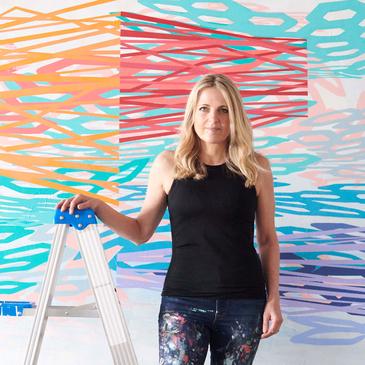
Artivist Series - Rebecca Rutstein
multidisciplinary artist and ocean explorer
Rebecca Rutstein is an accomplished artist who has received many awards and been involved in numerous public exhibitions. Rebecca’s career has taken her to remarkable places including the high seas and the ocean floor. In all, her artwork strives to build connections with nature, inspire wonder, and foster environmental stewardship.
She is the recipient of a Pew Fellowship in the Arts, has had her collaborations funded by the National Science Foundation and numerous international exhibitions including an immersive video installation currently on view at the National Academy of Sciences in Washington D.C. Rebecca has participated in seven expeditions at sea including two to the bottom of the ocean. Rebecca’s artwork strives to build connections with nature, inspire wonder, and foster environmental stewardship. Today, we will focus on her Artist at Sea series. Her latest artist at sea residency, her seventh, was aboard the University of Hawaii’s Research /Vessel Kilo Moana. The work created from that residency is to be exhibited this year at Woods Hole Oceanographic Institution, Oregon State University and James Madison University in Virginia.
What Rebecca talks about …
Her artistic journey grew out of an introductory geology course for art majors during her undergraduate studies at Cornell University. In this class she took field trips to state parks to see the exposed geology. It planted a seed for later works of art. About a decade later, she began to think of incorporating the idea of geologic forces causing upheaval as a metaphor for human relations. Then she began a genuine pursuit of working to know more about geology and learn more about geology in different parts of the world. She was involved in a variety of artistic residencies. In one she studied a map of the ocean floor, a map of the ocean floor made from sound waves. Rebecca was fascinated by the landscape and used it as a springboard for her future artistic studies.
Her personal challenge is to express the science without being didactic. She wants the viewer to have a visceral experience. It’s also really challenging to work on a boat which is constantly in motion. Before a trip, I have to anticipate what to bring as it’s not like there’s an art supply store down the street. This means she has to anticipate what she might want to use. Another challenge is the motion of the ship. It can be very intense at times. Her first expedition was during a hurricane. The pitch and roll of the ship was quite drastic. What drew ger back to the second residency was that she’d fallen in love with the ocean – the solitude, the peacefulness of it - combined with the exuberance of working with scientists and exploring. We were uncovering new terrain. All the residencies has been amazing but the two that were most impactful for her were the two she went down on Alvin, the deep sea submersible: once off the coast of Costa Rica, the other off the coast of Mexico in the Gulf of California. It was the most incredible experience in her lifetime as it framed her place in the world and impacted her creatively as an artist. Any fear she might have had in traveling more than 1.5 miles below the ocean surface was overridden by the opportunity. She was inside a 6-ft. titanium spear with two other people – a pilot and another passenger. It took 1 ½ hours to descend. The sense of scale is hard to describe. She was in an area off of Mexico where there were vents of superheated water and unusual life. Her art work rather than describing the landscape focuses on the microbes that exist there and the networks they create. Rebecca discusses a permanent exhibit at Georgia Museum of Art that grew out of her experience in Alvin. It’s a 64-ft. installation that relates to the bio- luminescent light of the microbes.
What concerns her about the state of the ocean is all the plastic she’s seen. Even more than a mile down she’s seen plastic bottles. She’s also seen damaged coral. There’s much to be concerned about as every ecosystem has been negatively affected by human activity. But Rebecca also has hope as she believes that the ocean is a resilient ecosystem. The microbes seem able to adjust and adapt. She also believes that humans can adapt too as there is an interest in bringing people together. “There is an energy to bring different voices together to solve different issues and challenges.”
